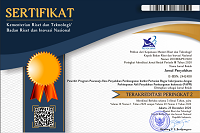The Influence of Participatory Technology and Institutional Participation of Farmer Groups on Farmer Business Development
Pengaruh Teknologi Partisipatif dan Partisipasi Kelembagaan Kelompok Tani Terhadap Pengembangan Usaha Tani
Abstract
Janti Village, Jogoroto, Jombang has a corn productivity of 2020 reaching 84.5 Kw/Ha, this achievement exceeds national average corn productivity. However, this is inversely proportional to the unstable price of corn, which can even be far from the normal price. Besides, the lack of farmer participation makes the problem drag on longer. The existence of farmer group institutions is very important to solve this problem. In addition, the application of participatory technology to farmers also provides clear goals for future agricultural production activities. Therefore, it is necessary to be active and participate in the Janti Village farmer group members. The purpose of this study is to describe the influence of participatory technology (discussions, workshops, and action planning) and institutional participation of farmer groups (participation in planning, implementation, utilization of results, and evaluation) on farming development (social, economic, and environmental) in Janti Village. Jogoroto District, Jombang Regency. The research method uses descriptive quantitative data collection techniques namely interviews, observation, and questionnaires. Previously, the questionnaire had to be tested for validity and reliability tests to support the validity of the research data obtained. The sampling method used is a simple random sample. Then the data analysis used is multiple linear regression analysis using the ordinary least square method including data tabulation, estimation of multiple linear regression models, classical assumption tests, regression feasibility tests, and interpretation of multiple linear regression models. Results showed that there was no significant effect if independent variables moved independently on dependent variables. Meanwhile, if independent variables move simultaneously, there will be a significant influence between participatory technology and the institutional participation of farmer groups in the development of farming businesses.
Downloads
References
Arikunto, S. (2006). Metodologi Penelitian Suatu Pendekatan Praktek. Jakarta: Rineka Cipta.
Elita, D. (2019). Evaluasi Pelaksanaan Program Desa Maju Inhil Jaya (DMIJ) Desa Nusantara Jaya Kecamatan Keritang Kabupaten Indragiri Hilir. Fakultas Ekonomi dan Ilmu Sosial Universitas Islam Negeri Sultan Syarif Kasim.
Ghozali. (2016). Aplikasi Analisis Multivariete Dengan Program IBM SPSS. Semarang: Badan Penerbit Universitas Diponegoro.
Hakim, A. 2020. Programa Penyuluhan Pertanian Desa Janti. Balai Penyuluhan Pertanian Jombang: Tidak diterbitkan
Hamyana, & Romadi, U. (2017). Pembangunan dan Konflik Sosial di Masyarakat Desa (Studi Etnografi Implementasi Program Upaya Khusus Peningkatan Produksi Padi, Jagung, dan Kedelai di Kabupaten Bondowoso-Jawa Timur). Jurnal Agriekonomika. 6(2)
Indriana, H. (2015). Teknologi Partisipatif Dalam Rangka Penguatan Kelembagaan Pertanian Organik Yang Berkelanjutan. tersedia: core.ac.uk/download/pdf/198230018.pdf. [22 Desember 2020]
Kalesaran, F., Rantung, V. V., & Pioh, N. R. (2015). Partisipasi dalam Program Nasional Pemberdayaan Masyarakat Mandiri Perkotaan Kelurahan Taas Kota Manado. Jurnal Ilmiah Society, 1(15), 56–73.
Malia, R., & Rahayu, L. S. (2019). Pengaruh Penyuluhan Melalui Metode Ceramah dan Diskusi terhadap Tingkat Pengetahuan Teknologi Sistim Tanam Legowo di Kelompok Tani Karya Mukti III Desa Sukakarya Kecamatan Sukanagara Kabupaten Cianjur. Jurnal AGROSCIENCE, 4(1), 51–60.
Mulyono., (2019). Analisis Asumsi Uji Klasik. SCS Business Mathematics and Statistics, Management Dept., Binus Business School Undergraduate Program. Tersedia: bbs.binus.ac.id/management/2019/12 /analisis-uji-asumsi-klasik/. [22 Desember 2020].
Nasdian, F. T. (2014). Pengembangan Masyarakat. Yayasan Pustaka Obor: Indonesia.
Nasrul, W. (2012). Pengembangan Kelembagaan Pertanian Untuk Peningkatan Kapasitas Petani Terhadap Pembangunan Pertanian. 3(29), 166–174.
Ngatija. (2019). Partisipasi Masyarakat Dalam Musyawarah Perencanaan Pembangunan Desa (Musrenbangdes) Di Desa Kanigoro Kecamatan Saptosari Kabupaten Gunungkidul. Program Magister Ilmu Pemerintahan Sekolah Tinggi Pembangunan Masyarakat Desa (APMD) Yogyakarta.
Notoatmodjo, S. (2012). Metodologi Penelitian Kesehatan. PT. Rineka Cipta.
Peraturan Menteri Pertanian nomor 273/Kpts/OT. 160/4/2007.
Qasim, M., & Maskiah, M. (2016). Perencanaan Pengajaran dalam Kegiatan Pembelajaan. Jurnal Diskursus Islam, 4(3), 484–492.
Rivai, R. S., & Anugrah, I. S. (2011). Konsep dan Implementasi Pembangunan Pertanian Berkelanjutan di Indonesia. Pusat Sosial Ekonomi dan Kebijakan Pertanian.
Rosyida, I., & Nasdian, F. T. (2011). Partisipasi Masyarakat Dan Stakeholder Dalam Penyelenggaraan Program Corporate Social Responsibility (CSR) Dan Dampaknya Terhadap Komunitas Perdesaan. Jurnal Sosiologi Pedesaan, 5(1).
Santoso, E. B., & Therik, L. V. (2016). Faktor Penentu Bertempat Tinggal Pada Kawasan Kumuh Di Kota Malang Berdasarkan Teori Doxiadis. Tata Loka, 18(4), 261–273.
Sapja, A. (2011). Kelembagaan Petani: Peran dan Strategi Pengembangan Kapasitasnya. Jurnal Sosial Ekonomi Pertanian Dan Agribisnis, 7(2).
Sugiyono, S. (2013). Metode Penelitian Kuantitatif Kualitatif dan R&D. Bandung: Alfabeta.
Suryapermana, N. (2017). Manajemen Perencanaan Pembelajaran. Tarbawi: Jurnal Keilmuan Manajemen Pendidikan, 3(02), 183–193.
Taufik, N. I. (2015). Pembinaan Guru Matematika SMA Dalam Menyusun Silabus Berkarakter Melalui Lokakarya. AdMathEdu, 5(2), 151–160.
Wibowo, H. S. (2015). Metode Evaluasi Pembelajaran Inklusif bagi Peserta Didik Difabel Netra. INKLUSI Journal of Disability Studies, 2(1), 87–108.
Zakaria, W. A. (2009). Penguatan Kelembagaan Kelompok Tani Kunci Kesejahteraan Petani. Lampung: Fakultas Pertanian Universitas Lampung.
Authors who publish with this journal agree to the following terms:
- Authors retain copyright and grant the journal right of first publication with the work simultaneously licensed under a

This work is licensed under a Creative Commons Attribution 4.0 International License that allows others to share the work with an acknowledgement of the work's authorship and initial publication in this journal. - Authors are able to enter into separate, additional contractual arrangements for the non-exclusive distribution of the journal's published version of the work (e.g., post it to an institutional repository or publish it in a book), with an acknowledgement of its initial publication in this journal.
- Authors are permitted and encouraged to post their work online (e.g., in institutional repositories or on their website) prior to and during the submission process, as it can lead to productive exchanges, as well as earlier and greater citation of published work (See The Effect of Open Access).















